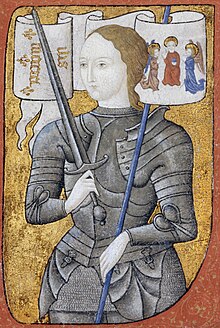
Back Жанна д’Арк Abkhazian Johanna van Arkel Afrikaans Jeanne d’Arc ALS ዣን ዳርክ Amharic Chuana d'Arco AN جان دارك Arabic جان دارك ARZ জোন অফ আৰ্ক Assamese Xuana d'Arcu AST Janna Dark Azerbaijani
Joan of Arc | |
|---|---|
 Historiated initial depicting Joan of Arc[a] | |
| Virgin | |
| Born | c. 1412 Domrémy, Duchy of Bar, Kingdom of France |
| Died | 30 May 1431 (aged approx. 19) Rouen, English-held Normandy |
| Venerated in | |
| Beatified | 18 April 1909 by Pope Pius X |
| Canonized | 16 May 1920 by Pope Benedict XV |
| Feast | 30 May |
| Patronage | France |
| Signature | |
 | |
Joan of Arc (French: Jeanne d'Arc [ʒan daʁk]; Middle French: Jehanne Darc [ʒəˈãnə ˈdark]; c. 1412 – 30 May 1431) is a patron saint of France, honored as a defender of the French nation for her role in the siege of Orléans and her insistence on the coronation of Charles VII of France during the Hundred Years' War. Claiming to be acting under divine guidance, she became a military leader who transcended gender roles and gained recognition as a savior of France.
Joan was born to a propertied peasant family at Domrémy in northeast France. In 1428, she requested to be taken to Charles VII, later testifying that she was guided by visions from the archangel Michael, Saint Margaret, and Saint Catherine to help him save France from English domination. Convinced of her devotion and purity, Charles sent Joan, who was about seventeen years old, to the siege of Orléans as part of a relief army. She arrived at the city in April 1429, wielding her banner and bringing hope to the demoralized French army. Nine days after her arrival, the English abandoned the siege. Joan encouraged the French to aggressively pursue the English during the Loire Campaign, which culminated in another decisive victory at Patay, opening the way for the French army to advance on Reims unopposed, where Charles was crowned as the King of France with Joan at his side. These victories boosted French morale, paving the way for their final triumph in the Hundred Years' War several decades later.
After Charles's coronation, Joan participated in the unsuccessful siege of Paris in September 1429 and the failed siege of La Charité in November. Her role in these defeats reduced the court's faith in her. In early 1430, Joan organized a company of volunteers to relieve Compiègne, which had been besieged by the Burgundians—French allies of the English. She was captured by Burgundian troops on 23 May. After trying unsuccessfully to escape, she was handed to the English in November. She was put on trial by Bishop Pierre Cauchon on accusations of heresy, which included blaspheming by wearing men's clothes, acting upon visions that were demonic, and refusing to submit her words and deeds to the judgment of the church. She was declared guilty and burned at the stake on 30 May 1431, aged about nineteen.
In 1456, an inquisitorial court reinvestigated Joan's trial and overturned the verdict, declaring that it was tainted by deceit and procedural errors. Joan has been described as an obedient daughter of the Roman Catholic Church, an early feminist, and a symbol of freedom and independence. She is popularly revered as a martyr. After the French Revolution, she became a national symbol of France. In 1920, Joan of Arc was canonized by Pope Benedict XV and, two years later, was declared one of the patron saints of France. She is portrayed in numerous cultural works, including literature, music, paintings, sculptures, and theater.
- ^ Contamine 2007, p. 199: Cette miniature du XVe siècle, très soignée (l'étendard correspond exactement à la description que Jeanne d'Arc elle-même en donnera lors de son procès) ... Mais c'est précisément cette exactitude, et cette coïncidence, trop belle pour être vraie, qui éveillent—ou plutôt auraient dû éveiller—les soupçons ... [This miniature from the 15th century, very neat (the banner corresponds exactly to the description that Joan of Arc herself will give during her trial) ... But it is precisely this exactitude, and this coincidence, too good to be true, which arouses—or rather should have aroused—suspicion ...]
- ^ The Calendar 2021.
Cite error: There are <ref group=lower-alpha> tags or {{efn}} templates on this page, but the references will not show without a {{reflist|group=lower-alpha}} template or {{notelist}} template (see the help page).